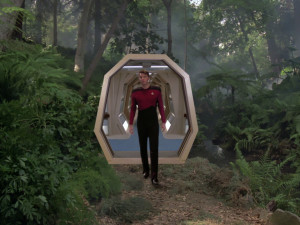
When I first watched R2D2 beam a hologram of a distraught Princess Leia onto a tabletop, I was more interested in how I could get my hands on that technology than I was about her problem (don’t judge—I was little and it was the beginning of the movie). I wasn’t allowed to touch our family’s answering machine, so the idea of a holographic message blew my mind. And then there was Star Trek’s holodeck, an entire simulated environment used for training, crime scene investigation, and recreation (Deep Space Nine’s Quark has particular fun renting out holosuites). The Emergency Medical Hologram could stand in for an real doctor, though unlike the holographic Leia, the EMH is an actual character who has a family and other relationships, many with actual people. There are even holo-novelists who write narratives for the holodeck—perhaps this will turn out to be a job of the future.

This technology is now reality. This week Microsoft revealed its HoloLens. The holographic computing system is part Star Wars, part Star Trek, and part something else that transcends both of them. The system projects holograms, but does so in three dimensions, rather than two, taking images “out of the screen and into the world.” What’s really exciting about the HoloLens isn’t just that it can project these images, but that it also the actual physical stuff in a user’s environment into holograms users can interact with, thus merging digital and actual reality. It seems appropriate that Google should retire Glass at the same time this system was announced—what the HoloLens does is far beyond anything Glass could do (except perhaps the looking silly part).

Those invited to test out the visor-like system experienced a few different scenarios that merged the virtual world with the actual world. For example, one demo turned a user’s real environment into a Minecraft version of that environment, transforming, among other objects, the actual coffee table into a Minecraft one. Microsoft has been pretty tight-lipped about how the system works, but it’s thought that the holographic images are actually projected into the eye of the user, tricking their brain into thinking, in this case, that the coffee table is made from Minecraft bricks (the visor is also equipped with sensors to monitor the wearer’s head movements to make sure the projections are properly oriented). So what happens when the user takes a virtual Minecraft hammer and smashes the table? It splinters into pieces before their eyes.

Other demos included getting electrical (or plumbing) help via the HoloLens camera, which allowed an actual electrician to see the light switch in question and give verbal and drawn instructions about how to fix it. There’s also something called HoloStudio, an app for creating 3D objects that can then be printed. But I think the most exciting scenario involves scientists using the HoloLens to “work” on Mars. This one uses OnSight software developed by folks at NASA’s Jet Propulsion Laboratory. It allows scientists to see through the eyes of the Curiosity rover so they can explore Mars, interact with 3D holographic images, and even perform experiments on Mars.

The system sounds similar to that of Magic Leap, a company recently purchased by Google that is developing “cinematic reality,” which is a step beyond virtual or augmented reality. The HoloLens may end up competing with Magic Leap, especially for hardware, but Microsoft doesn’t see virtual reality systems such as Oculus Rift, Project Morpheus, or Glyph as competitors: “We are integrating holograms into the world around you–transforming the ways you create, connect, and explore. Oculus, Magic Leap, Glass developers and everyone else, we humbly invite you–come create holograms with us.” It’s worth noting that Oculus Rift can be used to generate holographic environments too, including a room that pays homage to the holodeck.
In conjunction with the announcement, Microsoft also revealed Windows 10, which will feature “holographic experiences.” Windows 8 and 8.1 users can upgrade for free (right now the Technical Preview is available to “Windows Insider” users). And if my previous experiences with Windows updates are any indication, we’ll all be forced to upgrade at some point soon whether we want to or not–unless Obi Wan can do something to stop it.
